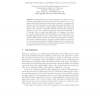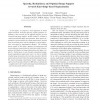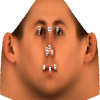ICRA
2006
IEEE
15 years 6 months ago
2006
IEEE
— Mobile robots do not adequately represent the objects in their environment; this weakness hinders a robot’s ability to utilize past experience. In this paper, we describe a s...
112
Voted
IROS
2008
IEEE
15 years 6 months ago
2008
IEEE
Abstract— Perceiving human faces is one of the most important functions for human robot interaction. The active appearance model (AAM) is a statistical approach that models the s...
115
click to vote
SMA
2009
ACM
15 years 6 months ago
2009
ACM
In this paper, we present a semi-automatic approach to efficiently and robustly recover the characteristic feature curves of a given free-form surface. The technique supports a s...
79
Voted
ICB
2009
Springer
15 years 7 months ago
2009
Springer
For multi-view face alignment (MVFA), the non-linear variation of shape and texture, and the self-occlusion of facial feature points caused by view change are the two major difficu...
113
click to vote
ECCV
2004
Springer
16 years 2 months ago
2004
Springer
Abstract. Statistical shape and texture appearance models are powerful image representations, but previously had been restricted to 2D or 3D shapes with smooth surfaces and lambert...
121
Voted
ICCV
2003
IEEE
16 years 2 months ago
2003
IEEE
We present an image-based approach to infer 3D structure parameters using a probabilistic "shape+structure" model. The 3D shape of an object class is represented by sets...
107
Voted
ICCV
2007
IEEE
16 years 2 months ago
2007
IEEE
Reliable segmentation of the left ventricle is a long sought objective in medical imaging for automatic retrieval of anatomical and pathological measurements and detection of malf...
125
click to vote
ICCV
2007
IEEE
16 years 2 months ago
2007
IEEE
In this paper, a novel object class detection method based on 3D object modeling is presented. Instead of using a complicated mechanism for relating multiple 2D training views, th...
CVPR
2008
IEEE
16 years 2 months ago
2008
IEEE
In this paper, we propose a novel approach to model shape variations. It encodes sparsity, exploits geometric redundancy, and accounts for the different degrees of local variation...
110
click to vote
CVPR
2007
IEEE
16 years 2 months ago
2007
IEEE
This paper presents a novel statistical shape model that can be used to detect and localise feature points of a class of objects in images. The shape model is inspired from the 3D...






